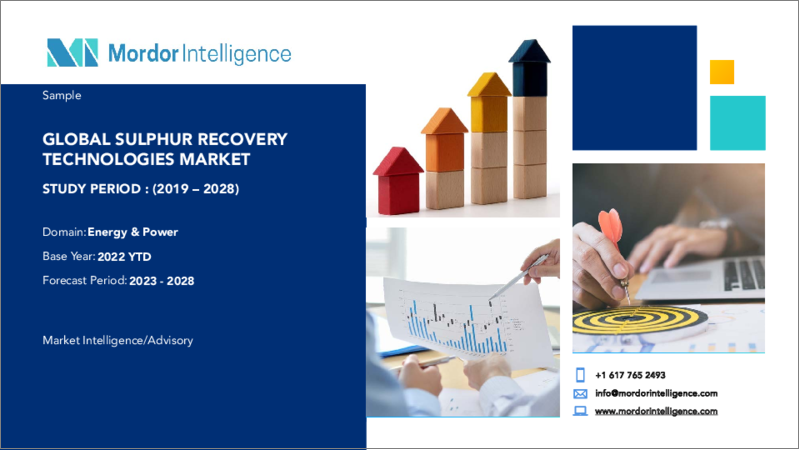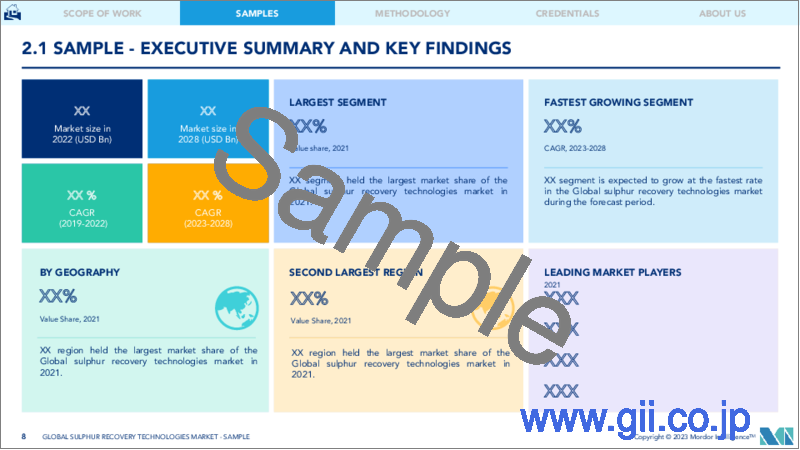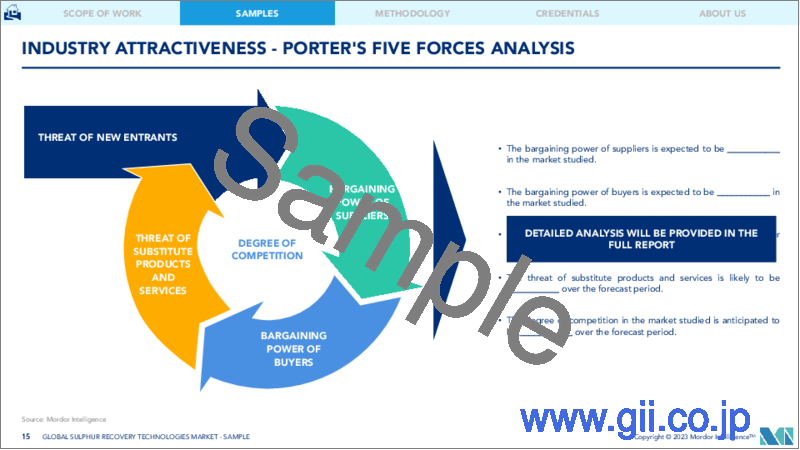|
|
市場調査レポート
商品コード
1198522
硫黄回収技術市場- 成長、動向、予測(2023年~2028年)Sulphur Recovery Technologies Market - Growth, Trends, and Forecasts (2023 - 2028) |
||||||
|
● お客様のご希望に応じて、既存データの加工や未掲載情報(例:国別セグメント)の追加などの対応が可能です。 詳細はお問い合わせください。 |
|||||||
| 硫黄回収技術市場- 成長、動向、予測(2023年~2028年) |
|
出版日: 2023年01月23日
発行: Mordor Intelligence
ページ情報: 英文 110 Pages
納期: 2~3営業日
|
- 全表示
- 概要
- 目次
硫黄回収技術市場は、期間中に2.33%以上のCAGRで成長すると予測されています。
COVID-19は2020年に市場にマイナスの影響を与えました。現在、市場は現在、パンデミック前の水準に達しています。
主なハイライト
- 長期的には、環境意識と規制が硫黄回収技術市場を牽引。事業者は、輸送や電力などの活動から排出される硫黄を最大限削減しようと努めており、硫黄回収技術はそのための有効なソリューションであるため、世界市場を牽引しています。
- 一方、硫黄含有量を減らすために必要な高いコストは、硫黄回収技術市場の阻害要因となっています。
- LNGバンカリングは予測期間以降も急速に増加すると予想されます。水上輸送にLNGを使用する船舶の増加に伴い、ガスの脱硫が普及することが予想されます。そのため、硫黄回収技術市場の成長機会を提供します。
- 石油・ガスの生産量増加、環境規制の強化、精製能力の向上により、アジア太平洋地域が予測期間中最大の市場となり、需要の大部分は中国とインドからもたらされると予想されます。
硫黄回収技術の市場動向
市場を独占する可能性が高いのは製油所セグメント
- 製油所は硫黄回収技術の主要なエンドユーザーであり、硫黄回収ユニット(SRU)は硫黄を回収する上で製油所に極めて重要です。例えば、ガソリンやディーゼル中の硫黄分を減らすことで、排ガス規制が改善され、製品が使用される際の大気汚染が軽減されるからです。
- 石油・ガス精製プラントの拡張投資の増加や、世界の環境意識・規制の高まりから、今後数年間は精製所が硫黄回収技術市場を独占すると予想されます。
- 特にIMO規則2020の輸送セグメントにおける新しい規制は、燃料中の硫黄含有量を減らすことに重点を置いています。IMOは、指定された排出規制地域外で運航する船舶について、船上で使用する燃料油の硫黄含有量を0.50%m/m(質量比)に制限することを定めています。原油の精製がより進むことで、硫黄回収市場の拡大が期待されます。
- 2021年の世界の石油精製能力は36,478千バレル/日に達し、2020年の36459千バレル/日から微増を記録しています。そのほとんどは、米国、中国、インド、日本、サウジアラビア、ASEAN諸国などの国々から供給されています。さらに、これらの国々は主に炭化水素と炭化水素由来の製品に依存しています。
- 近年、いくつかの国では、将来の需要に対応するため、硫黄回収技術を含む石油精製装置の拡張とアップグレードに大きな進展が見られています。例えば、2022年9月、ニューバーグエンジニアリングのエネルギー・インフラ事業部門は、インド石油公社(IOC)のコヤリ製油所・石油化学コンプレックスにおける拡張計画の一環として、650億インドルピー(約8億円)のSRUを建設する予定であることを発表しました。
- 国営IOCは2021年、先に発表したVadodaraのKoyali製油所の原油処理能力拡張計画に石油化学と潤滑油プラントを追加する覚書をグジャラート州政府と締結しました。IOCは、石油化学と潤滑油の統合プロジェクト(LuPech)およびコヤリでのアクリル/オキソアルコールプロジェクトの一環として、ポリプロピレン年間50万トンおよび潤滑油ベースストック23万トンの生産工場とともに、精製能力を年間430万トン増強し、1800万トンとする計画を進めているところです。コヤリでの総投資額は約24,000ルピーにのぼる予定です。
- したがって、クリーン燃料の需要増加に伴い、世界の硫黄回収技術市場は予測期間中に大幅に増加することが予想されます。
アジア太平洋地域が市場を独占
- アジア太平洋地域は、インドや中国などの新興国と、日本、韓国、オーストラリアなどの先進国の存在により、世界で最も急速に成長している地域の1つです。2021年現在、アジア太平洋地域は世界の硫黄回収技術市場において重要な地域の一つであり、同地域における製油所などのエネルギー集約型産業の急成長により、予測期間中もその優位性が続くと思われます。
- 2021年、中国は世界第2位の石油消費国でありながら、第6位の石油生産国です。同国は、輸入への依存度を下げ、エネルギー安全保障を向上させるため、炭化水素需要の50%近くを輸入しています。中国は、四川盆地など様々な内陸のシェール盆地にまたがる国内埋蔵量を開発し、シェールの潜在力を最大限に引き出そうとしています。中国におけるシェールガス開発は、ここ数年で着実に増加し、2017年以降、毎年21%増加しています。2021年のシェールガス生産量は約22億立方フィート/日(Bcf/d)となり、2020年までの政府目標である29億立方フィート/日を下回りました。
- 中国におけるシェール革命は、前例のない石油化学設備の創出と拡張をもたらしました。その結果、中国は内需をなだめ、国内産業向けの石油化学工程を削減するために、精製・石油化学インフラに大規模な投資を行いました。食品包装、衣料、化粧品、肥料など、プラスチックやその他の石油化学製品の需要が増え続けているため、需要の増加に対応するために精製能力を増強する必要があります。
- 中国はIMOの新ガイドラインを受け入れており、精製部門の近代化に対する投資を増やすことで、硫黄回収技術の成長をさらに後押しすると予想されます。また、中国は新しい製油所の建設や古い製油所のアップグレードと能力増強も行っています。2021年現在、中国では180万bpd近くの新規精製能力が建設中であり、そのほとんどが2022年に稼働すると予想されています。また、国内の複数の製油所では、拡張・アップグレード作業が進行中です。
- さらに、2022年半ばには、ペトロチャイナが中国南部の子会社製油所を統合石油化学コンプレックスに拡張する45億2000万米ドルのプログラムを開始しました。同国第2位の国営石油精製会社は、広西石油化学工場の原油精製能力を維持する一方、14の主要石油化学ユニットを追加すると予想されます。こうした投資により、今後数年間は硫黄回収技術の需要が高まると予想されます。
- さらに、2022年3月には、インドの多国籍エンジニアリングコングロマリットであるThermax Ltdが、インドの公共部門製油所から、同社の硫黄回収ブロックをLSTKベースで設置する1億4902万米ドルの受注を成立させました。この硫黄回収設備は、現在進行中の製油所拡張プロジェクトに組み込まれる予定です。この画期的なプロジェクトは、インド政府が推進する「North East Hydrocarbon Vision 2030」の一環として進められているものです。
- したがって、アジア太平洋地域は、大規模な石油・ガス精製部門と、よりクリーンな化石燃料への需要の増加により、市場を独占すると予想されます。
硫黄回収技術市場の競合他社分析
硫黄回収技術市場は、適度に断片化されています。この市場の主要プレイヤー(順不同)には、Enersul Limited Partnership、WorleyParsons Limited、Shell Plc、Bechtel Corporation、Fluor Corporationなどが挙げられます。
その他の特典
- エクセル形式の市場予測(ME)シート
- 3ヶ月間のアナリストサポート
目次
第1章 イントロダクション
- 調査対象範囲
- 市場の定義
- 調査の前提
第2章 調査手法
第3章 エグゼクティブサマリー
第4章 市場の概要
- イントロダクション
- 市場規模・需要予測(単位:億米ドル、2027年まで)
- 精製所設置容量(2021年まで)
- 精製品の硫黄含有量許容値(単位:百万トン/年、2023年まで)
- 最近の動向と展開
- 政府政策と規制
- 市場力学
- 促進要因
- 抑制要因
- サプライチェーン分析
- ポーターのファイブフォース分析
- 供給企業の交渉力
- 消費者の交渉力
- 新規参入業者の脅威
- 代替品の脅威
- 競争企業間の敵対関係
第5章 市場セグメンテーション
- アプリケーション
- 製油所
- ガス処理プラント
- 発電所
- その他
- 地域別
- 北米
- アジア太平洋地域
- 欧州
- 南米
- 中東
第6章 競合情勢
- M&A、ジョイントベンチャー、コラボレーション、合意書
- リーディングプレイヤーが採用した戦略
- 市場シェア分析
- 企業プロファイル
- Enersul Limited Partnership
- WorleyParsons Limited
- Shell Plc
- Bechtel Corporation
- Fluor Corporation
- Sulfur Recovery Engineering Inc.
- Ortloff Engineers, Ltd.
- Air Liquide S.A.
第7章 市場機会と今後の動向
The Sulphur Recovery Technologies Market is expected to grow at a CAGR of more than 2.33% over the period.
COVID-19 negatively impacted the market in 2020. Presently the market has now reached pre-pandemic levels.
Key Highlights
- Over the long term, environmental awareness and regulations drive the Sulphur Recovery Technologies Market. Operators are striving for maximum reduction of sulphur emission from activities such as transportation and electricity, for which the sulphur technologies are a viable solution, thereby driving the global market.
- On the other note, the high cost required to reduce the sulphur content is a restraint for the Sulphur Recovery Technologies Market.
- LNG Bunkering is expected to increase rapidly beyond the forecast period. De-sulfurization of gas is expected to proliferate with the increase in the number of ships using LNG for water transportation. Thereby providing an opportunity for growth in the Sulphur recovery technologies market.
- Due to high oil and gas production, increased environmental regulations, and increased refining capacity, Asia-Pacific is expected to be the largest market during the forecast period, with most demand coming from China and India.
Sulphur Recovery Technologies Market Trends
Refineries Segment Likely to Dominate the Market
- The refineries are a key end-user of sulphur recovery technologies, as the Sulfur Recovery Unit (SRU) is extremely vital in the Refinery in recovering sulfur. For example, reducing the sulfur content in gasoline and diesel improves emission controls and reduces air pollution when the products are used.
- Refineries are expected to dominate the sulphur recovery technologies market in the coming years owing to the increasing investments in expanding the oil & gas refining plants and the growing environmental awareness and regulations globally.
- New regulations, especially in the transportation segment under the IMO rules, 2020, heavily focus on decreasing sulphur content in the fuel. For ships operating outside designated Emission Control Areas, IMO has set a limit for sulphur in fuel oil used on board ships of 0.50% m/m (mass by mass). More refining of crude oil is expected to boost the sulphur recovery market.
- In 2021, the total global oil refining capacity has reached 36,478 thousand barrels per day, recording a slight increase from 36459 thousand barrels per day in 2020. Most of the capacity has come from the countries such as the United States, China, India, Japan, Saudi Arabia, and other ASEAN countries. Further, the countries are primarily dependent on hydrocarbons and hydrocarbon-derived products.
- In recent years, several countries are making significant developments in expanding and upgrading their oil refinery units, including sulphur recovery technologies, to cater the future demands. For instance, in September 2022, the energy and infrastructure business unit of Nuberg Engineering announced it is set to build an INR 650 crore SRU for Indian Oil Corporation (IOC) as part of the latter's expansion plans at the Koyali refinery and petrochemical complex.
- In 2021, the state-owned IOC signed a memorandum of understanding (MoU) with the Government of Gujarat to add petrochemical and lube plants to its previously announced plans to expand crude oil processing capacity at Koyali refinery at Vadodara. IOC is in the process of developing refining capacity by 4.3 million tonnes per annum to 18 million tonnes per annum, along with plants to produce 500,000 tonnes per annum of polypropylene and 235,000 tonnes of lube oil base stock as part of its petrochemical and lube integration (LuPech) project and acrylics/oxo alcohol project at Koyali. The total investment at Koyali will be to the tune of around Rs 24,000 crore.
- Therefore, with the increase in demand for clean fuel, the global sulphur recovery technologies market is expected to increase considerably during the forecast period.
Asia-Pacific to Dominate the Market
- Asia-Pacific is one of the fastest-growing regions in the world, owing to the presence of emerging countries, like India and China, and developed countries, such as Japan, South Korea, and Australia. As of 2021, the Asia-Pacific region is one of the significant regions in the global Sulphur recovery technologies market and is likely to continue its dominance during the forecast period, owing to the rapid growth in energy-intensive industries like refineries in the region.
- In 2021, China is the world's 2nd largest oil consumer but the 6th largest oil producer. The country imports nearly 50% of its hydrocarbon demand to reduce dependence on imports and improve energy security. China has been trying to maximize its shale potential by exploiting its domestic reserves across various inland shale basins, such as the Sichuan basin. The shale gas development in China has increased steadily in the past few years, growing 21% annually since 2017. In 2021, shale gas production totaled about 2.2 Billion cubic feet per day (Bcf/d), below the government target of 2.9 Bcf/d by 2020.
- The shale revolution in China has resulted in unprecedented petrochemical capacity creation and expansion. As a result, China has made significant investments in refining and petrochemical infrastructure to placate domestic demand and reduce the petrochemical process for domestic industries. Due to an ever-rising demand for plastics and other petrochemicals from food packaging, clothing, cosmetics, and fertilizers, refining capacity must be increased to handle the growing demand.
- China has accepted the new IMO guidelines and is expected to further aid the growth of sulphur recovery technologies by increasing its investments into the modernization of the refining sector. Also, China is also building new refineries and upgrading and adding capacity in older refineries. As of 2021, nearly 1.8 million bpd of new refining capacity is under construction in China, with most expected to come online in 2022. In addition, expansion and upgradation operations are ongoing at multiple refineries in the country.
- Further, in mid-2022, PetroChina launched a USD 4.52 billion programs to expand a subsidiary refinery in southern China into an integrated petrochemicals complex. The country's second-largest state refiner is expected to keep crude oil refining capacity at the Guangxi Petrochemical plant unchanged while adding 14 major petrochemical units. Such investments are expected to boost the demand for sulphur recovery technologies in the coming years.
- Moreover, in March 2022, Thermax Ltd, an Indian multinational engineering conglomerate, has concluded an order of USD 149.02 million from an Indian public sector refinery to set up their sulphur recovery block on LSTK basis. The sulphur recovery block will be a part of the customer's ongoing refinery expansion project. This landmark project is being pursued as a part of the government of India's North East Hydrocarbon Vision 2030.
- Hence, the Asia-Pacific region is expected to dominate the market due to its large oil and gas refining sector and increasing demand for cleaner fossil fuel.
Sulphur Recovery Technologies Market Competitor Analysis
The Sulfur Recovery Technologies Market is moderately fragmented. Some of the key players in this market (not in particular order) include Enersul Limited Partnership, WorleyParsons Limited, Shell Plc, Bechtel Corporation, and Fluor Corporation, amongst others.
Additional Benefits:
- The market estimate (ME) sheet in Excel format
- 3 months of analyst support
TABLE OF CONTENTS
1 INTRODUCTION
- 1.1 Scope of the Study
- 1.2 Market Definition
- 1.3 Study Assumptions
2 RESEARCH METHODOLOGY
3 EXECUTIVE SUMMARY
4 MARKET OVERVIEW
- 4.1 Introduction
- 4.2 Market Size and Demand Forecast in USD billion, till 2027
- 4.3 Refinery Installed Capacity, till 2021
- 4.4 Allowed Sulphur Content in Refined Products in Million tons per year, till 2023
- 4.5 Recent Trends and Developments
- 4.6 Government Policies and Regulations
- 4.7 Market Dynamics
- 4.7.1 Drivers
- 4.7.2 Restraints
- 4.8 Supply Chain Analysis
- 4.9 Porter's Five Forces Analysis
- 4.9.1 Bargaining Power of Suppliers
- 4.9.2 Bargaining Power of Consumers
- 4.9.3 Threat of New Entrants
- 4.9.4 Threat of Substitutes Products and Services
- 4.9.5 Intensity of Competitive Rivalry
5 MARKET SEGMENTATION
- 5.1 Application
- 5.1.1 Refineries
- 5.1.2 Gas Processing Plants
- 5.1.3 Power Plants
- 5.1.4 Others
- 5.2 Geography
- 5.2.1 North America
- 5.2.2 Asia-Pacific
- 5.2.3 Europe
- 5.2.4 South America
- 5.2.5 Middle-East
6 COMPETITIVE LANDSCAPE
- 6.1 Mergers and Acquisitions, Joint Ventures, Collaborations, and Agreements
- 6.2 Strategies Adopted by Leading Players
- 6.3 Market Share Analysis
- 6.4 Company Profiles
- 6.4.1 Enersul Limited Partnership
- 6.4.2 WorleyParsons Limited
- 6.4.3 Shell Plc
- 6.4.4 Bechtel Corporation
- 6.4.5 Fluor Corporation
- 6.4.6 Sulfur Recovery Engineering Inc.
- 6.4.7 Ortloff Engineers, Ltd.
- 6.4.8 Air Liquide S.A.




